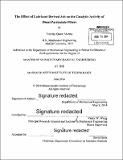| dc.contributor.advisor | Victor W. Wong. | en_US |
| dc.contributor.author | Murray, Timothy Quinn | en_US |
| dc.contributor.other | Massachusetts Institute of Technology. Department of Mechanical Engineering. | en_US |
| dc.date.accessioned | 2014-12-08T18:54:58Z | |
| dc.date.available | 2014-12-08T18:54:58Z | |
| dc.date.copyright | 2014 | en_US |
| dc.date.issued | 2014 | en_US |
| dc.identifier.uri | http://hdl.handle.net/1721.1/92182 | |
| dc.description | Thesis: S.M., Massachusetts Institute of Technology, Department of Mechanical Engineering, 2014. | en_US |
| dc.description | Cataloged from PDF version of thesis. | en_US |
| dc.description | Includes bibliographical references (pages 89-91). | en_US |
| dc.description.abstract | A diesel particulate filter (DPF) is an aftertreatment device used to remove hazardous particulate matter (PM) from diesel engine exhaust. Modem emission restrictions have limited the acceptable amount of PM output by diesel engines to the extent that a filtration strategy, such as the use of a DPF, is necessary. Diesel PM is comprised primarily by black carbon soot. Once trapped in the filter, the soot can be oxidized into CO2 and pass out of the exhaust system during what is referred to as regeneration. Metallic lubricant additive derived compounds, which make up a small fraction of PM, cannot be oxidized and remain inside the DPF until regular maintenance calls for the removal and cleaning of the filter. The buildup of ash increases the pressure drop across the filter, resulting in a direct fuel penalty to the engine. The oxidation of soot can be carried out actively at high temperatures or passively at low temperatures with the aid of a catalyst. Active regeneration requires more energy than passive regeneration because the stream of exhaust gas must be heated to a higher temperature. However, catalysts are expensive, and therefore there is a significant additional capital cost associated with catalyzed filters. The purpose of this research was to investigate the impact of ash accumulation on the catalytic activity of DPFs. The impact was measured experimentally by comparing the ability of two ash loaded DPF samples to promote several chemical reactions (most importantly soot oxidation) to the ability of a previously unused (clean) filter. It was shown that ash accumulation results in a loss in the catalytic activity of a DPF, as evidenced by a reduced capacity to generate NO2, and promote the catalyzed passive oxidation of soot. Reduced soot oxidation performance will result in faster accumulation of soot, which increases the pressure drop across the filter and necessitates more frequent regenerations. Both of these results will negatively impact fuel economy. | en_US |
| dc.description.statementofresponsibility | by Timothy Quinn Murray. | en_US |
| dc.format.extent | 93 pages | en_US |
| dc.language.iso | eng | en_US |
| dc.publisher | Massachusetts Institute of Technology | en_US |
| dc.rights | M.I.T. theses are protected by copyright. They may be viewed from this source for any purpose, but reproduction or distribution in any format is prohibited without written permission. See provided URL for inquiries about permission. | en_US |
| dc.rights.uri | http://dspace.mit.edu/handle/1721.1/7582 | en_US |
| dc.subject | Mechanical Engineering. | en_US |
| dc.title | The effect of lubricant derived ash on the catalytic activity of diesel particulate filters | en_US |
| dc.type | Thesis | en_US |
| dc.description.degree | S.M. | en_US |
| dc.contributor.department | Massachusetts Institute of Technology. Department of Mechanical Engineering | |
| dc.identifier.oclc | 897206219 | en_US |
